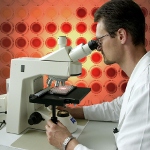Assessment of microbial risks in foods

Salmonella, Listeria, Campylobacter – and other bacteria as well as viruses in foods can constitute a health risk for humans. The task of BfR is to control the spreading of these microbial risks in the food chain and assess the health risk of contaminated foods and feeds. The control of pathogens starts as early as possible: during food production and processing.
Foodborne diseases caused by microorganisms
Microorganisms are – apart from malnutrition – the by far most frequent cause for foodborne diseases. Pathogens can occur in foods originating from animals but also in plant-based foods. The currently most important food infections, campylobacteriosis and salmonellosis originate above all in the primary production, i.e. the animal stocks.
Research on Salmonella infections and other zoonoses
Diseases which can be transmitted from animals to humans are referred to as zoonoses. In this connection the foodborne Listeria, toxoplasms and Yersinia are the most relevant.
The tasks of the BfR experts include research on zoonotic agents, their transmission and dissemination paths as well as the development of diagnostic methods which are suitable for routine examinations of foods.
A salmonellosis is an inflammatory disease of the gastro-intestinal tract (infectious gastroenteritis) caused by Salmonella (bacteria). It is caused by poor hygiene measures, the consumption of contaminated drinking water or contaminated foods.
Campylobacteriosis in turn refers to diseases which are caused by bacteria of the Campylobacter genus, a genus of spiral bacteria.
Reference laboratories for zoonotic agents
In view of controlling the most relevant zoonotic agents, BfR develops measures for a sustainably safe food production.
BfR hosts additional national reference laboratories for different zoonotic agents in order to meet the very high demands on securing consumer health protection.
Information
5
Wearing gloves when eviscerating animals protects hunters from hepatitis E (22.83 KB)
Food involved in disease outbreaks in Germany in 2009 (33.15 KB)
Hepatitis E virus in wild boars in Germany (26.39 KB)
Food involved in disease outbreaks in Germany in 2008 (29.95 KB)
Food involved in disease outbreaks in Germany in 2007 (27.20 KB)
Opinion
28
New Findings concerning "Bovine Meat and Milk Factors" (BMMF) (156.07 KB)
Reclaimed wastewater: preventing protozoa on plant foods (560.48 KB)
Bacterial foodborne Vibrio infections: health risk assessment of the occurrence of Vibrio spp. (non-cholera vibrios) in food (762.71 KB)
Comparing the genetic material of pathogens to explain disease outbreaks (245.16 KB)
New pathogens in beef and cow’s milk products: More research required (186.91 KB)
Brucellosis: Although risk of infection from mare's milk is low in Germany, BfR still recommends heat treatment (245.86 KB)
Raw milk: boiling protects against infection with Campylobacter (40.40 KB)
Salmonella control programme in accordance with Regulation (EC) No. 2160/2003: 2012 results (24.93 KB)
Salmonella control programme in accordance with Regulation (EC) No. 2160/2003: results for the year 2011 (31.67 KB)
High microbial load in sprouts and ready-to-eat salad mixtures (38.46 KB)
Pseudomonads have caused spoiled mozzarella cheese (32.11 KB)
Salmonella control programme according to Regulation (EC) No 2160/2003: Results for 2009 (30.35 KB)
Clostridium estertheticum in vacuum-packed beef: Health risk through consumption is unlikely (24.83 KB)
Q fever: transmission of Coxiella burnetii through the consumption of foods of animal origin unlikely (29.07 KB)
Occurrence of pathogenic mycobacteria in fattening pigs (30.65 KB)
Baseline study published on the occurrence of Campylobacter spp. and Salmonella spp. in broiler carcasses (31.45 KB)
EU programme to combat salmonella: 2008 results record a positive trend (27.89 KB)
Results of the baseline study on the prevalence of Salmonella spp. in holdings of breeding pigs presented (28.95 KB)
Basic study to record the prevalence of MRSA in pig breeding stocks (28.06 KB)
People can become infected with methicillin-resistant Staphylococcus aureus (MRSA) through contact with livestock (37.39 KB)
Hygienic efficiency of dishwashers for drinking glasses in the food service sector (29.34 KB)
MRSA in food? (30.81 KB)
Inadequately heated pork could contain sarcocysts (28.06 KB)
The temperature at which food is kept warm should be higher than 65 °C (37.56 KB)
Campylobacter spp. in duck breast (31.72 KB)
Arcobacter spp. in raw meat can trigger food-borne infections in humans (29.10 KB)
Wild boar meat may contain the harmful Alaria alata (28.47 KB)
From the scientific angle there is no region in Germany with a negligible Trichinella risk (31.22 KB)
FAQ
7
Hepatitis E virus: avoiding transmission via domestic pigs and wild boars and food derived from them (209.92 KB)
Avoiding infections - What should be considered when consuming raw milk? (255.59 KB)
Foodborne infections in private households – identifying sources and avoiding risks (288.95 KB)
Rare but avoidable: questions and answers about botulism (72.35 KB)
Selected questions and answers about barbecuing (64.85 KB)
Questions and answers on the transfer of TBE viruses through raw milk (33.29 KB)
Frequently Asked Questions on EHEC infections caused by vegetable foods (50.23 KB)
Other documents
1
Press releases
50
-
18.12.2009
Salmonella widespread in pig breeding farms
-
16.07.2021
African swine fever: No risk to consumers
-
14.09.2020
African swine fever: No risk to consumers
-
23.01.2018
African swine fever: No risk to consumers
-
17.09.2018
African swine fever: No risk to consumers
-
29.05.2009
Farm visit without stomach pains
-
12.11.2004
Fewer antibiotics, more hygiene
-
16.01.2008
Food should taste good - not make you sick
-
30.01.2019
Resistant germs - a global problem
-
28.01.2008
Risky delicacy: Pink duck breast
-
22.12.2011
Safe Food in Community Institutions
-
14.02.2005
Salmonella in pork – still a risk
-
15.01.2010
Toxoplasmosis: Underestimated risk
-
13.01.2012
Tracking down germs!
